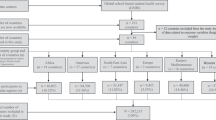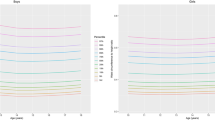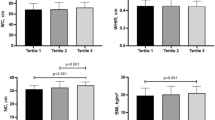Abstract
Background:
Waist circumference (WC) and waist-to-height ratio (WHtR) begin to gain attention as measures of adiposity and as important cardiometabolic disease risk factors also among children. Still, little research has been done on behavioral determinants of WC and WHtR in children. The purpose of this study was to examine associations between health behaviors, WC and WHtR in children.
Methods:
The study was a cross-sectional study conducted in Swedish-speaking schools in Helsinki region in 2006. In all, 1146 children were recruited, from which 55 % took part in the study. A total of 604 9–11-year-old children (312 girls, 292 boys) were measured by research staff and completed a study questionnaire on their health behaviors, including breakfast intake, TV viewing, sleep duration and physical activity, and a 16-item food frequency questionnaire. Covariance analysis was used as the statistical analysis method.
Results:
When controlling for other health behaviors, for example, irregular breakfast (B-coefficient 2.49 CI, 0.64–4.34; P<0.01), TV viewing (B-coefficient 0.89 CI, 0.17–1.61; P<0.05), a TV in child's room (B-coefficient 2.30 CI, 0.73-3.86; P<0.01) and physical inactivity during school breaks (B-coefficient 0.78 CI, 0.19–1.37; P<0.01) were associated with larger WC. Results were similar with WHtR.
Conclusions:
Many health behaviors were related to children's WC and WHtR. Determinants were associated to both WC and WHtR similarly.
This is a preview of subscription content, access via your institution
Access options
Subscribe to this journal
Receive 12 print issues and online access
$259.00 per year
only $21.58 per issue
Buy this article
- Purchase on Springer Link
- Instant access to full article PDF
Prices may be subject to local taxes which are calculated during checkout
Similar content being viewed by others
References
Albertson AM, Franko DL, Thompson D, Eldridge AL, Holschuh N, Affenito SG et al. (2007). Longitudinal patterns of breakfast eating in black and white adolescent girls. Obesity 15, 2282–2292.
Andersen LF, Lillegaard IT, Overby N, Lytle L, Klepp KI, Johansson L (2005). Overweight and obesity among Norwegian schoolchildren: changes from 1993 to 2000. Scand J Public Health 33, 99–106.
Bradlee ML, Singer MR, Qureshi MM, Moore LL (2010). Food group intake and central obesity among children and adolescents in the Third National Health and Nutrition Examination Survey (NHANES III). Public Health Nutr 13, 797–805.
Cossio S, Messiah SE, Garibay-Nieto N, Lopez-Mitnik G, Flores P, Arheart KL et al. (2009). How do different indices of obesity correlate with cardiometabolic disease risk factors in multiethnic youths? Endocr Pract 15, 403–409.
Currie C, Samdal O, Boyce W, Smith B (2001). Health behaviours in school-aged children: a World Health Organization cross-national study. (eds). Research protocol for the 2001/2002 survey. Edinburgh: Child and Adolescent Health Research Unit, University of Edinburgh.
Delmas C, Platat C, Schweitzer B, Wagner A, Oujaa M, Simon C (2007). Association between television in bedroom and adiposity throughout adolescence. Obesity 15, 2495–2503.
Dubois L, Girard M, Potvin Kent M, Farmer A, Tatone-Tokuda F (2009). Breakfast skipping is associated with differences in meal patterns, macronutrient intakes and overweight among pre-school children. Public Health Nutr 12, 19–28.
Goodman E, Hinden BR, Khandelwal S (2000). Accuracy of teen and parental reports of obesity and body mass index. Pediatrics 106, 52–58.
Gorely T, Marshall SJ, Biddle SJ (2004). Couch kids: correlates of television viewing among youth. Int J Behav Med 11, 152–163.
Halkjaer J, Sorensen TI, Tjonneland A, Togo P, Holst C, Heitmann BL (2004). Food and drinking patterns as predictors of 6-year BMI-adjusted changes in waist circumference. Br J Nutr 92, 735–748.
Hitze B, Bosy-Westphal A, Bielfeldt F, Settler U, Plachta-Danielzik S, Pfeuffer M et al. (2009). Determinants and impact of sleep duration in children and adolescents: data of the Kiel Obesity Prevention Study. Eur J Clin Nutr 63, 739–746.
Isacco L, Lazaar N, Ratel S, Thivel D, Aucouturier J, Dore E et al. (2010). The impact of eating habits on anthropometric characteristics in French primary school children. Child Care Health Dev 36, 835–842.
Jackson DM, Djafarian K, Stewart J, Speakman JR (2009). Increased television viewing is associated with elevated body fatness but not with lower total energy expenditure in children. Am J Clin Nutr 89, 1031–1036.
Janssen I, Katzmarzyk PT, Boyce WF, Vereecken C, Mulvihill C, Roberts C et al. (2005). Comparison of overweight and obesity prevalence in school-aged youth from 34 countries and their relationships with physical activity and dietary patterns. Obes Rev 6, 123–132.
Kahn HS, Imperatore G, Cheng YJ (2005). A population-based comparison of BMI percentiles and waist-to-height ratio for identifying cardiovascular risk in youth. J Pediatr 146, 482–488.
Klein-Platat C, Oujaa M, Wagner A, Haan MC, Arveiler D, Schlienger JL et al. (2005). Physical activity is inversely related to waist circumference in 12-y-old French adolescents. Int J Obes 29, 9–14.
Lanctot JQ, Klesges RC, Stockton MB, Klesges LM (2008). Prevalence and characteristics of energy underreporting in African-American girls. Obesity 16, 1407–1412.
Lazarou C, Soteriades ES (2010). Children's physical activity, TV watching and obesity in Cyprus: the CYKIDS study. Eur J Public Health 20, 70–77.
Lee CM, Huxley RR, Wildman RP, Woodward M (2008). Indices of abdominal obesity are better discriminators of cardiovascular risk factors than BMI: a meta-analysis. J Clin Epidemiol 61, 646–653.
Lee S, Bacha F, Gungor N, Arslanian SA (2006). Waist circumference is an independent predictor of insulin resistance in black and white youths. J Pediatr 148, 188–194.
Lehto R, Ray C, Lahti-Koski M, Roos E (2010). Meal pattern and BMI in 9–11-year-old children in Finland. Public Health Nutr Dec 6, 1–6.
Livingstone MB, Robson PJ (2000). Measurement of dietary intake in children. Proc Nutr Soc 59, 279–293.
McCarthy HD, Ashwell M (2006). A study of central fatness using waist-to-height ratios in UK children and adolescents over two decades supports the simple message—‘keep your waist circumference to less than half your height’. Int J Obes 30, 988–992.
McCarthy HD, Ellis SM, Cole TJ (2003). Central overweight and obesity in British youth aged 11–16 years: cross sectional surveys of waist circumference. BMJ 326, 624.
Moreno LA, Fleta J, Sarria A, Rodriguez G, Gil C, Bueno M (2001). Secular changes in body fat patterning in children and adolescents of Zaragoza (Spain), 1980–1995. Int J Obes Relat Metab Disord 25, 1656–1660.
Nambiar S, Truby H, Abbott RA, Davies PS (2009). Validating the waist-height ratio and developing centiles for use amongst children and adolescents. Acta Paediatr 98, 148–152.
Ortega FB, Ruiz JR, Sjostrom M (2007). Physical activity, overweight and central adiposity in Swedish children and adolescents: the European Youth Heart Study. Int J Behav Nutr Phys Act 4, 61.
Patel SR, Hu FB (2008). Short sleep duration and weight gain: a systematic review. Obesity 16, 643–653.
Rampersaud GC, Pereira MA, Girard BL, Adams J, Metzl JD (2005). Breakfast habits, nutritional status, body weight, and academic performance in children and adolescents. J Am Diet Assoc 105, 743–760; quiz 761–762.
Rangul V, Holmen TL, Kurtze N, Cuypers K, Midthjell K (2008). Reliability and validity of two frequently used self-administered physical activity questionnaires in adolescents. BMC Med Res Methodol 8, 47.
Ray C, Suominen S, Roos E (2009). The role of parents’ sense of coherence in irregular meal pattern and food intake pattern of children aged 10–11 in Finland. J Epidemiol Community Health 63, 1005–1009.
Ray C, Westerlund L, Roos E (2007). Do sleeping habits associate with meal pattern among 10–11 years old children? Eur J Public Health 17, 143 (abstract).
Reilly JJ, Kelly J, Wilson DC (2010). Accuracy of simple clinical and epidemiological definitions of childhood obesity: systematic review and evidence appraisal. Obes Rev 11, 645–655.
Reinehr T, Wunsch R (2010). Relationships between cardiovascular risk profile, ultrasonographic measurement of intra-abdominal adipose tissue, and waist circumference in obese children. Clin Nutr 29, 24–30.
Rexrode KM, Carey VJ, Hennekens CH, Walters EE, Colditz GA, Stampfer MJ . et al. (1998). Abdominal adiposity and coronary heart disease in women. JAMA 280, 1843–1848.
Roos E, Ray C, Stroor C (2009). Measuring children's health behaviours: comparing answers from 10- to 11year-old children and their parents. In: 7th International Conference on Diet and Activity Methods. Program and Abstracts: http://www.icdam.org/ICDAM_Program_Abstracts_Book.pdf, accessed 27 January 2011.
Sherry B, Jefferds ME, Grummer-Strawn LM (2007). Accuracy of adolescent self-report of height and weight in assessing overweight status: a literature review. Arch Pediatr Adolesc Med 161, 1154–1161.
Singh R, Martin BR, Hickey Y, Teegarden D, Campbell WW, Craig BA et al. (2009). Comparison of self-reported, measured, metabolizable energy intake with total energy expenditure in overweight teens. Am J Clin Nutr 89, 1744–1750.
Smith KJ, Gall SL, McNaughton SA, Blizzard L, Dwyer T, Venn AJ (2010). Skipping breakfast: longitudinal associations with cardiometabolic risk factors in the Childhood Determinants of Adult Health Study. Am J Clin Nutr 92, 1316–1325.
Stevens J (1992). Applied multivariate statistics for the social sciences. New Jersey: Lawrence Erlbaum Associates; 1992.
Sung RY, Yu CC, Choi KC, McManus A, Li AM, Xu SL et al. (2007). Waist circumference and body mass index in Chinese children: cutoff values for predicting cardiovascular risk factors. Int J Obes 31, 550–558.
Szajewska H, Ruszczynski M (2010). Systematic review demonstrating that breakfast consumption influences body weight outcomes in children and adolescents in Europe. Crit Rev Food Sci Nutr 50, 113–119.
Timlin MT, Pereira MA, Story M, Neumark-Sztainer D (2008). Breakfast eating and weight change in a 5-year prospective analysis of adolescents: Project EAT (Eating Among Teens). Pediatrics 121, e638–e645.
Vandewater EA, Huang X (2006). Parental weight status as a moderator of the relationship between television viewing and childhood overweight. Arch Pediatr Adolesc Med 160, 425–431.
Vereecken C, Dupuy M, Rasmussen M, Kelly C, Nansel TR, Al Sabbah H et al. (2009). Breakfast consumption and its socio-demographic and lifestyle correlates in schoolchildren in 41 countries participating in the HBSC study. Int J Public Health 54 (Suppl 2), 180–190.
Vereecken CA, Maes L (2003). A Belgian study on the reliability and relative validity of the Health Behaviour in School-Aged Children food-frequency questionnaire. Public Health Nutr 6, 581–588.
Westerlund L, Ray C, Roos E (2009). Associations between sleeping habits and food consumption patterns among 10–11-year-old children in Finland. Br J Nutr 102, 1531–1537.
Wildman RP, Gu D, Reynolds K, Duan X, Wu X, He J (2005). Are waist circumference and body mass index independently associated with cardiovascular disease risk in Chinese adults? Am J Clin Nutr 82, 1195–1202.
Yu Y, Lu BS, Wang B, Wang H, Yang J, Li Z et al. (2007). Short sleep duration and adiposity in Chinese adolescents. Sleep 30, 1688–1697.
Acknowledgements
We would like to thank all the study schools, children and their parents for the participation in the study. This study was supported by Juho Vainio Foundation, Päivikki and Sakari Sohlberg Foundation, Signe and Ane Gyllenberg Foundation, Medicinska understödsförening Liv och Hälsa.
Author information
Authors and Affiliations
Corresponding author
Ethics declarations
Competing interests
The authors declare no conflict of interest.
Rights and permissions
About this article
Cite this article
Lehto, R., Ray, C., Lahti-Koski, M. et al. Health behaviors, waist circumference and waist-to-height ratio in children. Eur J Clin Nutr 65, 841–848 (2011). https://doi.org/10.1038/ejcn.2011.49
Received:
Revised:
Accepted:
Published:
Issue Date:
DOI: https://doi.org/10.1038/ejcn.2011.49
Keywords
This article is cited by
-
Individual and family characteristics associated with health indicators at entry into multidisciplinary pediatric weight management: findings from the CANadian Pediatric Weight management Registry (CANPWR)
International Journal of Obesity (2022)
-
Phenome-wide investigation of the causal associations between childhood BMI and adult trait outcomes: a two-sample Mendelian randomization study
Genome Medicine (2021)
-
The relationship between the home environment and child adiposity: a systematic review
International Journal of Behavioral Nutrition and Physical Activity (2021)
-
Accelerometer-based physical activity levels, fundamental movement skills and weight status in British preschool children from a deprived area
European Journal of Pediatrics (2019)
-
Dieting status influences associations between dietary patterns and body composition in adolescents: a cross-sectional study
Nutrition Journal (2013)



